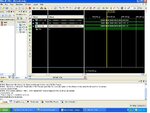fpga_freak
Newbie level 3
this is my code. i am using add and clock ip core. the output i am getting is 32 bit 0 stream. dont know what is problem, everything seems fine. i am getting two warnings at the of synthesize process and those are
WARNING:Xst:616 - Invalid property "SYN_BLACK_BOX 1": Did not attach to ad1.
WARNING:Xst:616 - Invalid property "SYN_NOPRUNE 1": Did not attach to ad1.
module pca(x,y,out,clk);
input [31:0] x,y;
input clk;
output [31:0] out;
addition ad1 (
.a(x), // input [31 : 0] a
.b , // input [31 : 0] b
, // input [31 : 0] b
.clk(CLK0_OUT), // input clk
.s(out) // output [31 : 0] s
);
clock clk1 (
.CLKIN_IN(clk),
.RST_IN(RST_IN),
.CLK0_OUT(CLK0_OUT),
.LOCKED_OUT(LOCKED_OUT)
);
now if anyone can help me sort it out. thank you
WARNING:Xst:616 - Invalid property "SYN_BLACK_BOX 1": Did not attach to ad1.
WARNING:Xst:616 - Invalid property "SYN_NOPRUNE 1": Did not attach to ad1.
module pca(x,y,out,clk);
input [31:0] x,y;
input clk;
output [31:0] out;
addition ad1 (
.a(x), // input [31 : 0] a
.b
.clk(CLK0_OUT), // input clk
.s(out) // output [31 : 0] s
);
clock clk1 (
.CLKIN_IN(clk),
.RST_IN(RST_IN),
.CLK0_OUT(CLK0_OUT),
.LOCKED_OUT(LOCKED_OUT)
);
now if anyone can help me sort it out. thank you
